
We all know that our supply chain is an integral part of what makes or breaks a company. When it's working correctly, there are no problems with production; but when something goes wrong in the process, you're going to see some severe delays come up!
What is the best way for any business owner/producer to help improve their chances of success while also minimizing risk from potential issues on-time delivery might entail? Investing time into figuring out where exactly those bumps typically occur, so they don't happen again—maybe learning how else businesses who deal mainly via internet order.
We get to handle essential practices about supply chain management. These are;
Develop a comprehensive understanding of your supply chain
Establish clear performance goals and objectives
Design and implement standardized processes across the entire supply chain
Implement effective inventory management practices
Use data analytics to optimize decision-making
Ensure efficient and effective communication throughout the supply chain
Collaborate with suppliers whenever possible
Foster a culture of continuous improvement within the organization
Stay up to date with industry trends and developments
Measure performance regularly and make necessary adjustments
Before we pass these meanings, it is essential to understand the supply chain management process and its importance. So, if you want to learn more about supply chain management, you can join an online supply chain management course.
What Are Practices For Improving Supply Chain Management(SCM)?
There's no doubt that a smooth-running supply chain is essential for any business – it's what keeps production humming along without any hitches. But even the best-laid plans can go awry, and when something goes wrong in the process, it can cause some severe delays.
1 - Develop a comprehensive understanding of your supply chain
It's essential to have a firm understanding of your entire supply chain, from the suppliers that provide your raw materials to the distributors that get your products to market. This way, you'll be able to identify any potential bottlenecks and address them before they cause problems.
2 - Establish clear performance goals and objectives
The best way to measure the success of your supply chain management is by setting measurable goals and objectives. This will help you track your progress and make necessary adjustments along the way. Be clear about what you want to accomplish and define specific metrics targets.
3 - Design and implement standardized processes across the entire supply chain
When everyone follows the same set of guidelines, it makes it easier to track and troubleshoot issues as they come up. This also helps ensure that everyone is working towards the same goals.
4 - Implement effective inventory management practices
To ensure that your products are always available when your customers need them. This includes regularly reviewing your stock levels and adjusting your ordering quantities accordingly. Additionally, you should establish a process for dealing with inaccurate or outdated inventory information.
5 - Use data analytics to optimize decision-making.
If you want to be a successful business, you need to make decisions based on data. The data collected by your supply chain can help you understand where and how to optimize your operations. This will help improve the flow of goods and minimize disruptions.
6 - Ensure efficient and effective communication throughout the supply chain
Communication is vital in any organization, but it's essential in a supply chain. When everyone is on the same page, it is easier to identify and correct any problems that may arise. Communication also helps ensure that everyone understands their roles and responsibilities.
7 - Collaborate with suppliers whenever possible
One of the best ways to smooth out any bumps in the production process is to collaborate with your suppliers as much as possible. By working together, you can develop strategies for dealing with potential problems before they even have a chance to occur. This will help keep things running smoothly and ensure that everyone remains on schedule.
8 - Foster a culture of continuous improvement within the organization
There's always room for improvement when it comes to supply chain management. Even if your business is running like a well-oiled machine, there are bound to be ways to make it run even more smoothly. Implementing a culture of continuous improvement will help ensure that your team is always looking for ways to improve the supply chain process.
9 - Stay up to date with industry trends and developments.
This one might seem like a no-brainer, but it's still worth mentioning. The supply chain landscape is constantly changing, so it's essential to stay up to date with the latest trends and developments to be prepared for anything. For example, if you're not already doing so, you may want to start using drones and 3D printing in your supply chain operations.
10 - Measure performance regularly and make necessary adjustments
It's important to constantly measure performance so that you can identify issues and make necessary adjustments. This means tracking production, delivery times, and inventory levels. Periodically reviewing your data will help you stay on top of any potential problems before they become more significant issues.
To be successful in supply chain management, it's important to constantly measure performance so you can identify issues and make adjustments. This means tracking production, delivery times, and inventory levels. Periodically reviewing your data will help you spot potential problems before they become more significant. If you want to learn more about effective supply chain management, join supply chain management online course today. You'll gain access to expert insights and best practices that will help you optimize your operations for success.
What are the different types of SCM practices?
There are several SCM practices, but the most common are supply chain management (SCM) and inventory management. SCM involves managing the flow of materials and information between suppliers, manufacturers, retailers, and customers. Inventory management focuses on addressing the inventory levels of a company's products. Other SCM practices include transportation management, warehousing management, and order fulfillment.
How to improve SCM through collaboration and communication?
There are several ways to improve SCM through collaboration and communication. First, ensure that all members of the SCM team are aware of the company's goals and objectives. Second, create clear and concise communication channels between members of the team. Third, establish regular meetings or forums where SCM team members can share ideas and information. Finally, encourage team members to work together on projects and tasks to foster a spirit of collaboration. By following these steps, you can improve SCM operations and make them more efficient and effective.
How to improve the flow of information in the supply chain?
One way to improve the flow of information in the supply chain is by implementing a collaborative platform for all stakeholders. A collaborative platform would allow for better communication and collaboration between suppliers, manufacturers, distributors, and retailers. It would help ensure that everyone is on the same page and that information flows seamlessly between all parties.
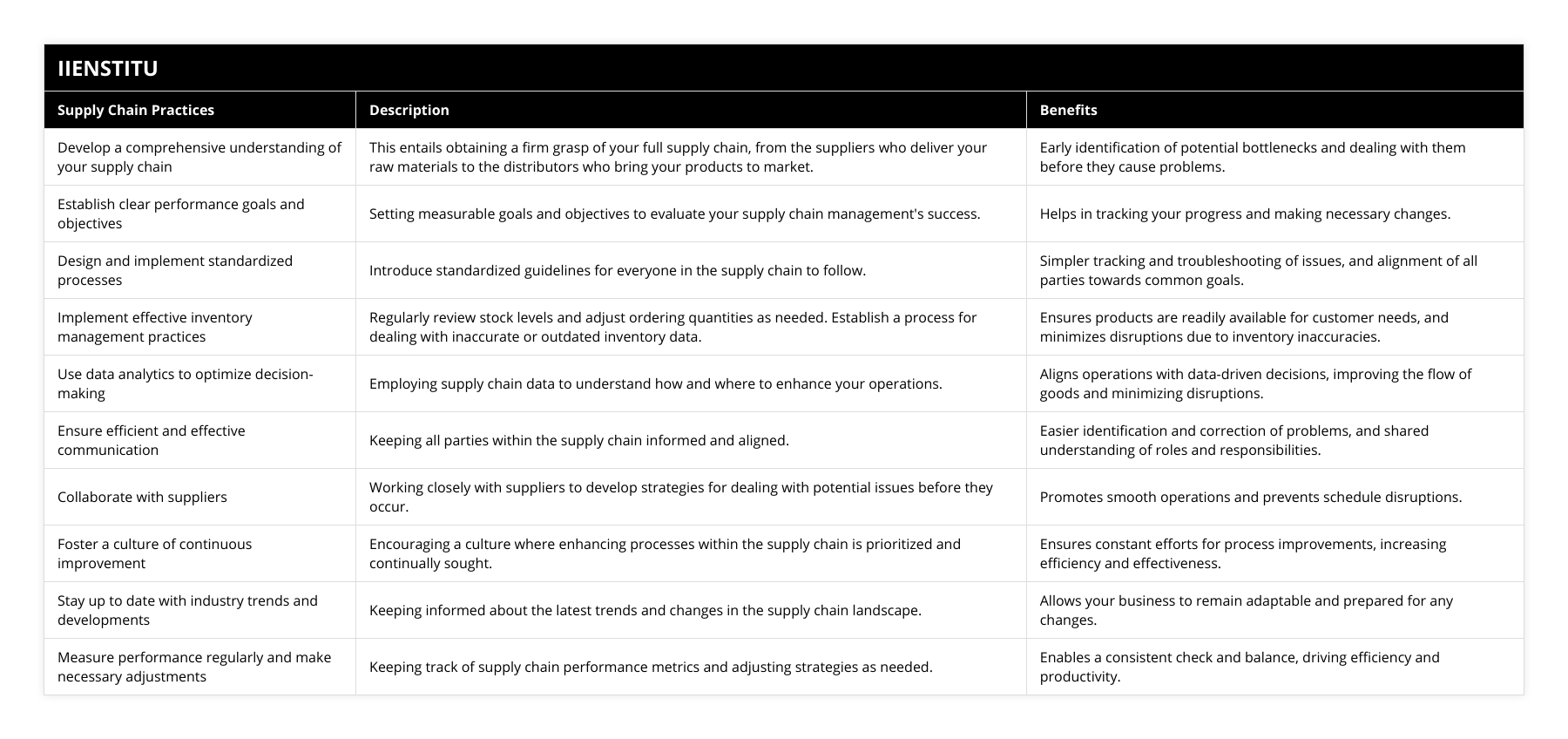
The successful functioning of a company significantly depends on its supply chain management. When this process is disrupted, it can lead to devastating delays in production. It is therefore crucial for businesses to understand their supply chains thoroughly, establish clear goals, standardized processes, effective inventory management, use data analytics, and ensure communication throughout the supply chain. Collaborating with suppliers and fostering a culture of continuous improvement is also vital. Business owners can stay updated with industry trends and measure performance regularly for adjustments. To improve their understanding and management of supply chains, they can take up supply chain courses online.
The text emphasizes several practices that can improve supply chain management, such as developing a comprehensive understanding of your supply chain, establishing clear objectives, standardizing processes, implementing effective inventory management, using data analytics, promoting efficient communication, fostering a culture of continuous improvement, and keeping current with industry trends. It also suggests collaboration with suppliers to prevent potential issues. Each of these principles are integral to the efficient operation of a business's supply chain and can be learned and developed through concerted effort, practical application, or education. For those seeking further understanding or improvement of their business, enrolling in a supply chain management online course is recommended.
Frequently Asked Questions
What are the different types of SCM practices?
There are several SCM practices, but the most common are supply chain management (SCM) and inventory management. SCM involves managing the flow of materials and information between suppliers, manufacturers, retailers, and customers. Inventory management focuses on addressing the inventory levels of a company's products. Other SCM practices include transportation management, warehousing management, and order fulfillment.

How to improve SCM through collaboration and communication?
There are several ways to improve SCM through collaboration and communication. First, ensure that all members of the SCM team are aware of the company's goals and objectives. Second, create clear and concise communication channels between members of the team. Third, establish regular meetings or forums where SCM team members can share ideas and information. Finally, encourage team members to work together on projects and tasks to foster a spirit of collaboration. By following these steps, you can improve SCM operations and make them more efficient and effective.

How to improve the flow of information in the supply chain?
One way to improve the flow of information in the supply chain is by implementing a collaborative platform for all stakeholders. A collaborative platform would allow for better communication and collaboration between suppliers, manufacturers, distributors, and retailers. It would help ensure that everyone is on the same page and that information flows seamlessly between all parties.

What are the five supply chain management practices?
Supply Chain Management Practices
Effective supply chain management (SCM) practices are crucial for companies in today's competitive business environment. There are five key practices that contribute to the success of SCM.
Strategic Supplier Partnerships
One of the most important SCM practices is establishing long-term strategic supplier partnerships. This enables companies to work closely with suppliers to reduce costs, improve quality, and enhance overall supply chain efficiency. Collaborative relationships with suppliers also allow for increased innovation and easier prediction of potential disruptions.
Customer Relationship Management
Understanding and catering to customer needs is a significant SCM practice. By focusing on customer needs assessment, segmenting markets, and customizing products and services, companies can respond more efficiently to various preferences. This can enhance customer satisfaction, which has the potential to improve sales and profitability as a result.
Cross-Functional Cooperation
Supply chain management requires cross-functional cooperation within the company, as it involves several departments, such as procurement, production, and logistics. To maximize efficiency and reduce potential errors and conflicts, effective communication and collaboration between departments are crucial. By involving all relevant departments in the SCM decision-making process, a company ensures that every contributor's perspective is considered.
Information Sharing and Transparency
Successful SCM relies on the accurate and timely sharing of information among supply chain partners. Transparent communication systems that enable real-time tracking of orders and inventory, and sharing of forecasts and demand schedules facilitate better decision making. Adopting technologies such as Electronic Data Interchange (EDI) and Enterprise Resource Planning (ERP) can significantly improve a company's ability to share and process valuable SCM data.
Agile and Responsive Supply Chains
In today's volatile business environment, companies must be prepared to adapt quickly to market fluctuations and consumer demand changes. Supply Chain Resilience, which is the capability to bounce back in the event of disruptions, is crucial. By adopting strategies such as inventory management, risk management, and adopting lean or just-in-time practices, companies can respond more effectively to supply chain disruptions and maintain business continuity.
In conclusion, implementing strategic supplier partnerships, customer relationship management, cross-functional cooperation, information sharing, and agile supply chains enables companies to optimize their SCM practices. By doing so, companies can enhance overall efficiency, reduce costs, increase customer satisfaction and, ultimately, maintain a competitive advantage in the marketplace.
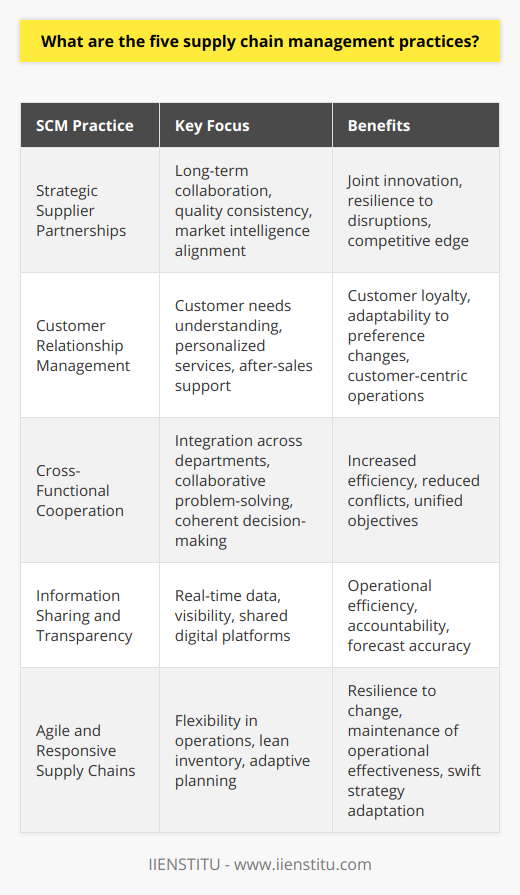
What are the 4 C's of supply chain management?
Understanding the 4 C's of Supply Chain Management
Integration and Coordination
The first 'C' in supply chain management is cooperation, which emphasizes the collaborative efforts among various entities within the network, such as suppliers, manufacturers, and distributors. Cooperation ensures that all parties are working together to achieve common goals, such as reducing costs, improving efficiency, and increasing customer satisfaction. It requires sharing of information, resources, and risks, and often entails the establishment of long-term strategic relationships.
Strengthening Communication
The second 'C' is communication, which is critical to the effective functioning of any supply chain. Communication involves the timely and accurate exchange of relevant information among stakeholders, including production schedules, delivery lead times, inventory levels, and demand forecasts. This ongoing dialogue not only enables supply chain partners to make informed decisions, but also helps them anticipate and respond to potential disruptions and changes in the market.
Building Commitment
The third 'C' is commitment, which refers to the dedication of individual stakeholders to achieving the supply chain's collective objectives. A high level of commitment is essential for the realization of operational and strategic goals and necessitates the development of trust among partners, as well as the alignment of interests and incentives. Ultimately, a committed supply chain fosters flexibility, adaptability, and resilience, driving sustained competitive advantage in the face of an evolving business environment.
Pursuing Continuous Improvement
Lastly, the fourth 'C' is continuous improvement, which represents the ongoing effort to identify, assess, and implement measures that enhance the overall performance of the supply chain. This process entails the adoption of lean principles and techniques, such as Six Sigma and just-in-time (JIT) delivery, to reduce waste, increase efficiency, and minimize lead times. Continuous improvement also embraces the concept of learning from past experiences and harnessing digital technologies to drive innovation and optimize performance across the supply chain.
In summary, the 4 C's of supply chain management encompass cooperation, communication, commitment, and continuous improvement, which together form the foundation of a well-functioning, competitive, and sustainable supply chain. By recognizing and actively working on these four components, businesses can not only achieve operational excellence but also maintain their position as key players in their respective markets.

What are the 7 prerequisites for a more successful supply chain management?
Assessing Supply Chain Management Needs
Firstly, effective communication is critical for successful supply chain management (SCM), as it enables organizations to share information, collaborate, and overcome potential challenges. Access to accurate and timely data ensures that all stakeholders remain informed, which leads to better decision-making and planning.
Alignment between departments
Secondly, the alignment of strategies and goals among different departments (e.g., procurement, manufacturing, distribution) is essential for SCM success. When departments work together toward a common vision, it results in a more efficient and responsive supply chain. In turn, this can lead to reduced lead times, costs, and increased customer satisfaction.
Technological infrastructure
Thirdly, implementing modern technology is crucial for streamlining supply chain processes and enhancing competitiveness. Utilizing advanced monitoring, inventory management, and analytics tools can provide organizations with valuable insights and help identify inefficiencies, risks, and opportunities for improvement within the supply chain.
Risk management
The fourth prerequisite is effective risk management. Identifying, assessing, and mitigating potential risks (e.g., disruption, cyber attacks, supplier failure) can enhance supply chain resilience and help maintain business continuity during unexpected events.
Supplier management
Developing and maintaining strong relationships with suppliers is the fifth prerequisite. Collaborative supplier partnerships allow organizations to coordinate efforts, share information, and adapt to changes more effectively, ultimately resulting in a more resilient supply chain.
Employee skill development
The sixth prerequisite relates to the development of employee skills and expertise in SCM. Providing training, coaching, and mentoring can equip employees with essential knowledge and competencies, leading to improved efficiency, innovation, and overall supply chain success.
Continuous improvement
Lastly, adopting a continuous improvement mindset encourages organizations to assess and refine their SCM practices regularly. By consistently analyzing supply chain performance and soliciting feedback from internal and external partners, organizations can identify areas for improvement and implement changes that drive overall supply chain success.
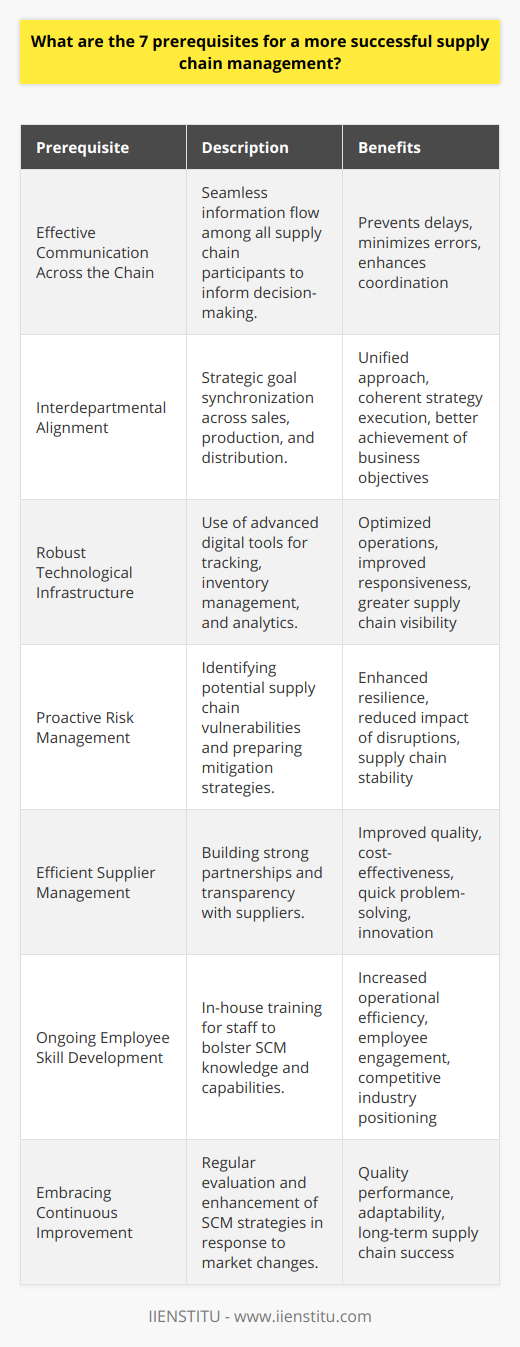
What are the key components of effective supply chain management?
Coordination and Communication
Essential components of effective supply chain management include robust coordination and communication. Organizations must ensure a seamless flow of information across every facet of their operations. Real-time data sharing and transparency become imperative, as they enable decision-makers to respond promptly to possible disruptions.
Technology Integration
Technology integration also holds paramount importance. Implementing advanced software solutions and analytical tools can bolster efficiency, reduce costs, and facilitate data-driven decisions. For instance, inventory management software aids in tracking stock levels and trends, while predictive analytics enable future demand forecasting.
Relationship Management
Effective supply chain management also requires strategic relationship management. Businesses should foster collaborative partnerships with their suppliers, distributors, and other entities involved in the supply chain process. Building strong win-win relationships can lead to improved service levels, risk sharing, and greater innovation.
Demand and Supply Alignment
Another key aspect lies in aligning demand with supply. This involves managing the fine balance between consumer needs and the organization's production capacity. Failure to align these elements might result in overproduction, or on the contrary, stock-outs.
Risk Management
Risk management is another crucial component. Supply chains are often vulnerable to various risks - economic changes, labor disputes, natural disasters, and more. Implementing proactive risk management strategies can mitigate such uncertainties, ensuring uninterrupted operations.
Process Improvement
Lastly, a keen focus on continuous process improvement is essential. Supply chain procedures should be consistently evaluated and updated to improve efficiency and effectiveness. This might involve streamlining warehouse operations, revamping transportation strategies, or adopting lean practices.
In conclusion, successful supply chain management involves a diverse collection of elements. It requires harmonizing each actor's needs within the supply chain, leveraging technology, fostering relationships, aligning demand with supply, managing risks, and promoting continuous improvement.
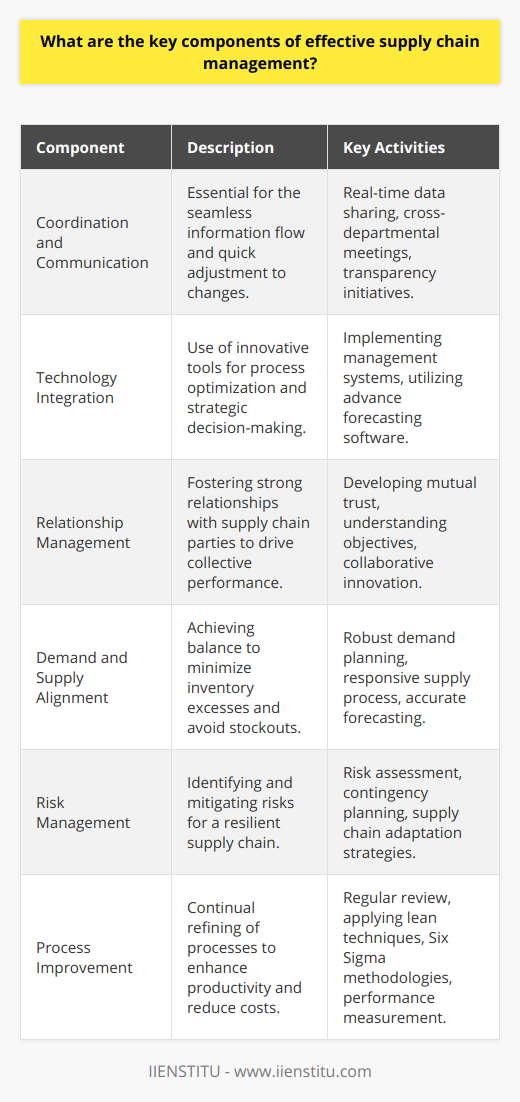
How can technology be utilized to optimize supply chain operations?
Enhancing Visibility and Coordination
Technology can significantly optimize supply chain operations by enhancing visibility and coordination. Real-time tracking systems, for example, allow businesses to monitor goods as they move through the supply chain, enhancing efficiency and accuracy.
Improving Forecasting and Demand Planning
Advanced analytics and machine learning can improve forecasting and demand planning. These tools evaluate historical patterns and market trends, enabling businesses to predict-demand accurately and optimize inventory management.
Increasing Speed and Efficiency
Automation technologies help increase speed and efficiency. Automated warehouses, for instance, reduce manual labor, speed up order fulfilment and minimize errors. Similarly, automated procurement systems streamline purchasing processes, making them quicker and more precise.
Facilitating Communication
Supply chain operations are more effective when communication between stakeholders is fluid. Technologies like cloud computing facilitate this by providing a shared platform where all parties can access and update information in real time.
Boosting Sustainability
Companies use technology to make their supply chains more sustainable. Blockchain, for example, enhances traceability, allowing businesses to evidence their sustainability claims and ensure responsible sourcing.
In conclusion, the integration of technology into supply chain management provides opportunities for superior visibility, improved demand forecasting, increased efficiency, smoother communication and enhanced sustainability. Businesses should strategically leverage technology to realize these benefits and excel in today's competitive market.
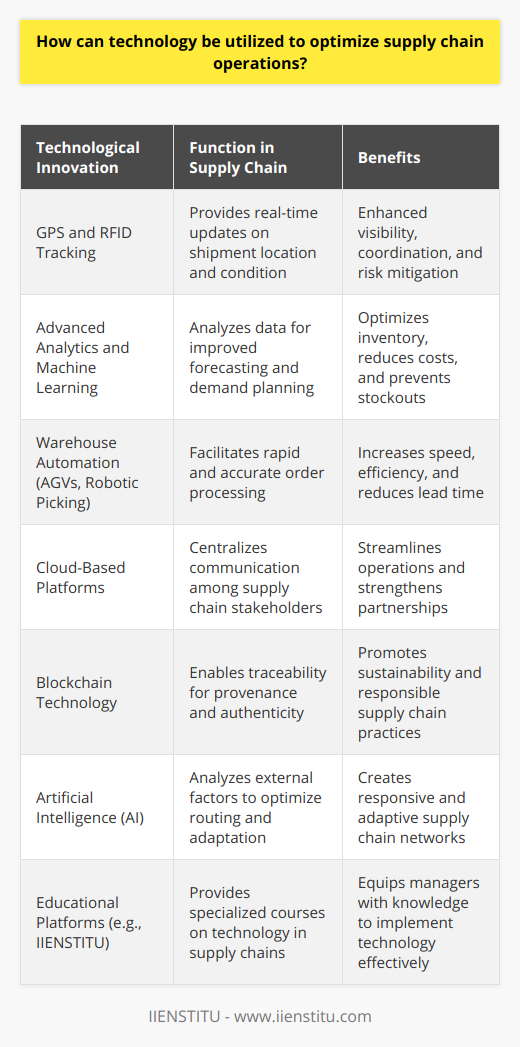
What role does sustainability play in modern supply chain management practices?
Importance of Sustainability
Sustainability is now a vital component in modern supply chain management (SCM). It ensures the efficient use of resources while minimizing environmental impact. Companies integrating sustainability in their SCM practices often find significant advantages, such as cost savings, enhanced brand reputation, and improved customer loyalty.
Sustainable Procurement
During procurement, companies can promote sustainability by choosing suppliers that prioritize sustainable practices. This step involves assessing vendors' environmental and social practices.
Optimized Operations
Sustainable operations aim to reduce waste, energy usage, and emission levels. A sustainable supply chain demands operational efficiency. Technology can aid in achieving these aims, including the use of advanced analytics and automation.
Maintenance and Supply Chain Lifecycle
Considering the entire lifecycle of products is another crucial aspect. It includes design, sourcing, production, transportation, usage, and disposal. Each stage should aim to mitigate environmental harm.
Waste Management
Proper waste management is critical for a sustainable supply chain process. Recycling and reusing resources can substantially reduce the supply chain's ecological footprint.
Consumer Awareness
Consumer awareness plays a significant role in driving sustainability in SCM. Companies that demonstrate commitment to sustainable practices often attract environmentally-conscious consumers, who increasingly prioritize sustainability when choosing which brands they engage with.
Regulatory Compliance
Regulations often stipulate sustainability in SCM. By integrating sustainable practices, companies can also ensure regulatory compliance, minimizing the risk of penalties and reputational damage.
In conclusion, sustainability serves a multi-functional role in supply chain management. In addition to contributing towards a healthier environment, it can enhance operational efficiency, promote customer loyalty, improve brand reputation, and ensure regulatory compliance. Therefore, while integrating sustainability is a significant endeavor, it presents an opportunity for long-term success for companies globally.
